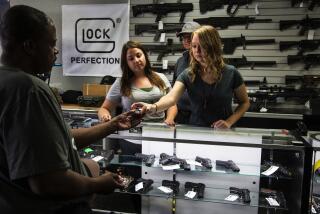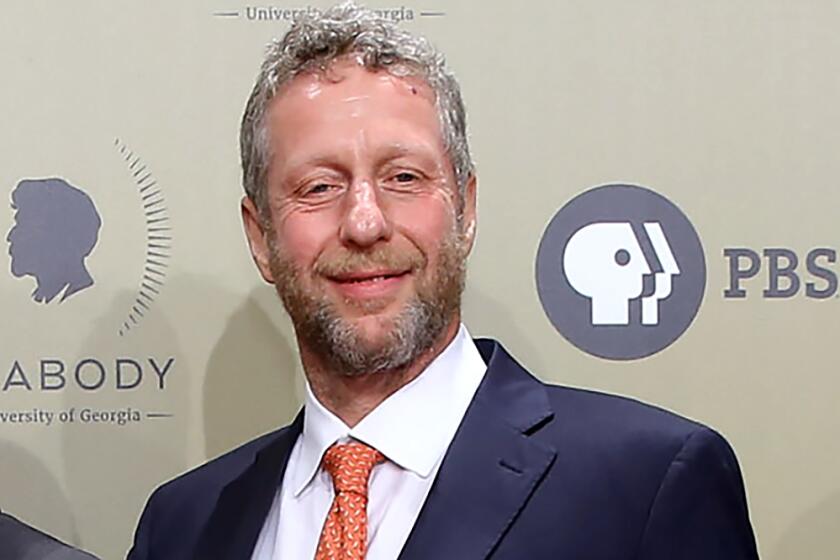10,000 Californians barred from owning guns are still armed. This law aims to change that
In response to the massacre at Sandy Hook Elementary School in Connecticut five years ago, outraged California lawmakers launched a crackdown within months of the tragedy that has seized 18,000 firearms, including assault rifles, from thousands of people convicted of felonies, subject to domestic violence restraining orders or judged by the courts to be severely mentally ill.
But a surge in gun sales and a reduction in funding for the program has stymied efforts by the state Department of Justice to eliminate a backlog of people in California who have firearms and shouldn’t. Approximately 10,226 people remain on a list of Californians who legally purchased guns but were later disqualified from possessing them.
For the record:
9:45 a.m. Jan. 19, 2018An earlier version of this article said that Proposition 63 banned the sale of large-capacity firearm magazines. It banned the possession of large-capacity firearm magazines.
Now, a new law is giving law enforcement officials hope that greater headway can be made in disarming Californians who are ineligible to own guns.
“Significantly, it means we finally have a process in place to ensure that dangerous, convicted criminals are forced to get rid of their guns,” said Lt. Gov. Gavin Newsom, who sponsored the new law as part of Proposition 63, a ballot measure that also included background checks on ammunition purchases and banned the possession of large-capacity firearm magazines. It was approved by voters in 2016.
In 2006, California became the first state in the nation to create a database that cross-references firearms purchasers against a list of people convicted of crimes, or who are subject to mental health judgments or domestic violence restraining orders that prohibit them from possessing guns.
The Armed and Prohibited Persons System identifies those who legally purchased guns but were later convicted of a felony or otherwise disqualified from holding firearms. However, the list of prohibited persons grew in its early years — faster than the understaffed state Department of Justice could seize guns in door-to-door searches.
For safety purposes, the DOJ sent five agents whenever an operation was undertaken to confront someone on the list and take away his or her guns.
While the DOJ was reducing the list by 2,000 people annually through arrests or confiscation of weapons, an additional 3,000 people were being added to the list each year.
By 2012, the number of people on the list reached nearly 20,000, who had 39,000 guns.
Later that year, a lone gunman entered Sandy Hook Elementary School in Newtown, Conn., and killed 20 children and six adults. Within days, California lawmakers outraged by the shooting introduced a package of bills to toughen the state’s already strict gun control laws.
The number of criminals with guns alarmed legislators including then-Sen. Mark Leno (D-San Francisco), who introduced a bill that allocated $24 million over three years to hire more DOJ agents and whittle the backlog down.
The list was reduced from 20,721 people in mid-2013 to 10,634 in 2016 when the grant program ended, and about $6 million was sent back to the fund that pays for point-of-sale background checks on gun buyers.
In 2016, the extra agents helped the DOJ and local law enforcement make 511 arrests and seize 3,954 firearms, including 187 assault rifles and four machine guns, as well as 947,653 rounds of ammunition.
The accuracy of the database is of concern to Craig DeLuz, a spokesman for the Firearms Policy Coalition, a group advocating for gun owners. When a temporary restraining order is lifted, a gun owner recovers the right to have guns, he said, adding that the change is not always recorded in a timely manner.
“When the information is inaccurate, you potentially put people at risk because you have the attorney general’s office sending armed SWAT teams to people’s homes to confiscate firearms,” DeLuz said.
The backlog problem has been made worse by a 2014 law change that added owners of long guns to the Armed and Prohibited Persons System list, which had previously comprised only handgun owners.
At the peak of funding, the DOJ had 82 agents and managers assigned to the program, but with extra funding gone, the force is down to 67.
In contrast to previous years when the annual backlog reduction was in the thousands, in the last year the number on the list has dropped from 10,634 to 10,226 this month.
State Atty. Gen. Xavier Becerra, who was appointed a year ago, remains committed to disarming criminals, according to aides who noted a jump in gun purchases and the addition of long guns to the Armed and Prohibited Persons list as obstacles to reducing the backlog.
“In recent years, we’ve seen a doubling of gun purchases, but are keeping up with the balance of the cases that are coming in,” said Bethany Lesser, a spokeswoman for Becerra. “It is dangerous and expensive to get guns out of the hands of people who are prohibited from owning them.”
More money and agents should be allocated to keep whittling away at the backlog, said Amanda Wilcox, policy chairwoman of the state chapter of the Brady Campaign to Prevent Gun Violence.
“I would, of course, like the number in APPS to be lower, but I also recognize the challenges and know that DOJ has disarmed thousands of dangerous armed and prohibited people over the years and made our state safer,” Wilcox said.
Leno is also concerned that the heightened effort stopped before the backlog was eliminated.
“The numbers are as few as they are due to the state’s investment in obtaining illegally possessed firearms,” he said this month.
A change in state law that took effect Jan. 1 is expected to help the state put a big dent in the backlog.
A provision of Proposition 63 requires people convicted of certain crimes to provide proof that they sold or transferred their firearms before the court finalizes their sentence. Failure to comply could affect the case and result in the court sending officers to recover the firearms.
Of the 7,700 people added to the database in 2014, about 42% — more than 3,200 people — were individuals who illegally retained firearms after a new criminal conviction.
The new law will not eliminate the backlog, but DOJ and elected officials hope it will reduce it significantly.
Newsom, who is running for governor, has touted the new law in a recent campaign-funded commercial that puts the goal bluntly.
“If you are a dangerous criminal, we really are coming for your guns,” Newsom says in the ad.
Leno, who is running for mayor of San Francisco, a city that once lost a mayor to gun violence, said more effort is required to disarm those judged by the courts to be too big a risk to have guns.
“If we don’t continue to direct our efforts and sufficient funds to this growing universe of illegally possessed firearms, it’s not a matter of if but when we will see another tragedy,” he said.
Twitter: @mcgreevy99
Updates on California politics
ALSO
California adopted some of the toughest gun control laws in country after multiple mass shootings
Federal judge blocks new California gun control law requiring disposal of large-capacity magazines
More to Read
Get the L.A. Times Politics newsletter
Deeply reported insights into legislation, politics and policy from Sacramento, Washington and beyond. In your inbox three times per week.
You may occasionally receive promotional content from the Los Angeles Times.







